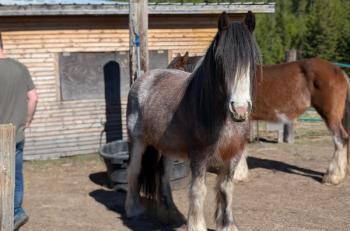
The fat middle-aged horse with laminitis (Proceedings)
Other names for this syndrome include Insulin resistance, Obesity-Associated Laminitis, Peripheral Cushing's Disease; Omental Cushing's Disease
Other names for this syndromes: Insulin resistance, obesity-associated laminitis, peripheral Cushing's disease, omental Cushing's disease
Criteria to meet: 1) Abnormal fat deposits (cresty neck, enlarged fat pads); 2) evidence of laminitis; 3) documentation of insulin resistance.
Classic Phenotype - middle-aged horses (> 6 yrs), may be obese (easy keepers), cresty neck, abnormal distribution of fat over the neck, rump, and prepuce and spontaneous, idiopathic laminitis. It is difficult for these horses to lose weight with dietary restriction and mares do not often breed successfully. Hair coat is NORMAL. Breed predilections include ponies, Morgans, Paso Finos, Norwegian Fjords, but can occur in any breed.
These horses had previously been considered (inappropriately) to be hypothyroid by most equine clinicians. Experimentally-induced hypothyroidism does not produce horses with these physical features. Horses with obesity and laminitis often have low circulating thyroid hormone concentrations, however, thyroid stimulation tests fail to support the diagnosis of hypothyroidism.
Pathogenesis:
The exact pathogenesis is unknown, but diet, genetics, and exercise all likely play a role.
Diet: feeding diets high in non-structural carbohydrates (NSC including starch, fructans) can lead to the development of obesity and insulin resistance. NSC = nonstructural carbohydrates = starch + water soluble carbohydrates (WSC). Water soluble carbohydrates = simple sugars + fructan (experimental studies- fructan can cause laminitis). Diets associated with insulin resistance can include sweet feeds, hay high in NSC, and in grazing.
Genetics: There has been anecdotal reports of certain breeds more likely to develop metabolic syndrome. Recent publication with Welsh and Dartmoor ponies revealed that pasture-associated laminitis was consistent with a dominant major gene or genes with reduce penetrance. "Thrifty gene"
Adipocytes: Omental adipocytes are endocrinologically active, and produce several hormones and cytokines. Omental adipocytes possess the enzyme, 11B-hyroxysteroid dehydrogenase- (11B-HSD-1) that converts circulating inactive cortisone to the physiologically active glucocorticoid cortisol.
Exercise: exercise will improve insulin sensitivity.
Diagnosis -
1. Signalment & Phenotype: (middle-aged fat, obese laminitic horse, normal haircoat)
2. Documentation of insulin resistance:
Resting Serum Insulin Concentrations:
Easiest screening test: Measure resting insulin concentrations in horses that have been fasted or only fed grass hay overnight. Avoid stress (chasing in a field, acute episode of laminitis). Several labs to choose from- but labs will have different normal values (and different units).
Diagnostic Center for Health and Animal Health at Michigan State University: normal ≤ 300 pmol/l; (or 43 uunits/ml)
University of Tennessee: ≤ 30 uunits/ml
Down side: mild or early IR – will not yet have hyperinsulinemia; also wide references ranges.
Combined Glucose-Insulin Test:
Better assessment of IR; Measure baseline glucose concentrations. Than infusion of 50% dextrose at 150 mg/kg bwt, followed by infusion of 0.1 units/kg of regular insulin. Blood samples collected for glucose concentrations at 1,5, 25, 35, 45, 60, 75, 90, 105, 120, 135, 150 min post infusion. Insulin resistance defined as blood glucose above resting values for 45 min. or greater.
Down side: small chance for hypoglycemia (keep 2 60 ml syringes of 50% dextrose ready- give if blood glucose < 40 mg/dl or clinical signs of hypoglycemia; stress will affect the values (including pain from laminitis, recommended use a catheter. Horses should be feed a grass hay overnight, and during the test.
Treatment –
There is no specific treatment for metabolic syndrome in horses. Goal- improves insulin sensitivity.
1. Weight Loss & Diet changes
Recommendations for feeding is to limit the NSC to < 12-10%.
Hay can range from <1% to >35% NSC per dry matter basis- can have hay tested, (Dairy One Forage Laboratory). Warm season grasses (prairie, Bermuda, and bluestem) contain little to no fructan. Timothy or orchard species are recommended rather than rye grass. Soaking hay (rinsing) will reduce the soluble sugars, but will reduce other nutrients from hay.
Obese Horses with IR:
Low carbohydrate, low calorie diet and exercise. Avoid feeds high in starch (sweet feed);
Grass/grazing: free choice grazing not recommended. In addition- stress, overgrazing, cold temperatures, and decreased water – all increase sugar in grass. Ways to avoid grass with high NSC- 1) limit grazing to early morning; 2) choose grazing areas in shade; 3) decrease/stop grazing when grass under stress from cool temperatures or frost, avoid grazing during early spring; 4) do not overgraze pastures; 5) establish a system of rotational grazing. If there is significant laminitis- stopping all grazing should be considered.
Mineral/vitamin supplementation:
Purina Mills: Natures Essentials- "Born to Win®"
Nutrena- Lite BalanceTM
Non-obese horse with IR:
Similar diet (low NSC) and exercise. However, if maintaining weight is a problem- can use feeds higher in fat (not carbohydrates)
20% of calories- fate in form of vegetable oil or rice bran
Commercial high fat, low carbohydrate feeds:
Purina: Ultium®
2. Exercise (if possible)
Exercise will result in weight loss and improve insulin sensitivity; every day would be ideal
3. Medications to improve insulin sensitivity
Chromium- 5-10 mg – many products, no harm
Magnesium, cinnamon...
Thyroid Supplementation- controversial- Philosophical argument that this is not indicated (horses are not hypothyroid), but product has been shown to result in weight loss and improve insulin sensitivity. Recommendation- 4 teaspoons (48 mg) once a day. Treated horses can be weaned off levothyroxine once ideal body weight is established. Wean off slowly. 2 teaspoons (24 mg) once a day for 2 weeks, then 1 teaspoon (12 mg) once a day for 2 weeks.
4. Treat Laminitis: There are many different treatments for laminitis. However the basics remain the same. 1) treat the underlying disease; 2) use of analgesics (including NSAID, and if necessary butorphanol or morphine); 3) use of anti-inflammatory drugs (phenylbutazone, DMSO?), 4) sole support to decrease tension of the laminae (frog supports, sand). Other additional therapies that have been advocated include the use of vasodilator drugs, and more recently the use of ice (24-72 hours) to prevent laminitis.
Newsletter
From exam room tips to practice management insights, get trusted veterinary news delivered straight to your inbox—subscribe to dvm360.






